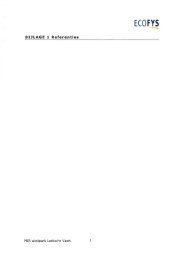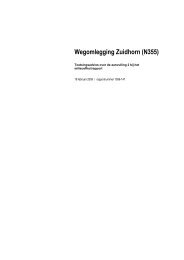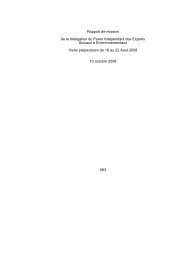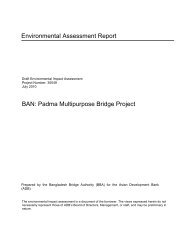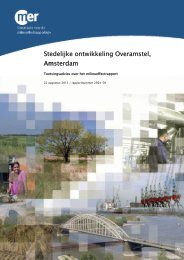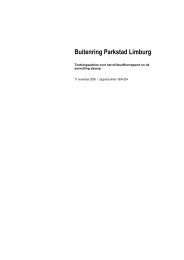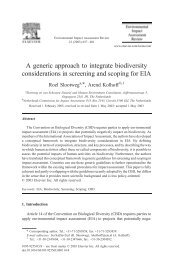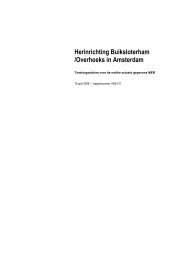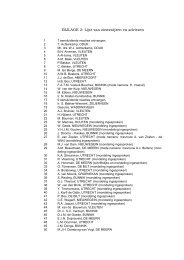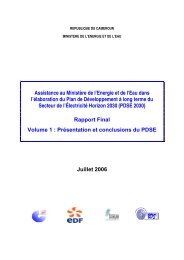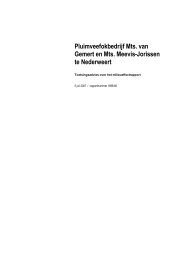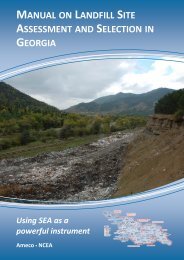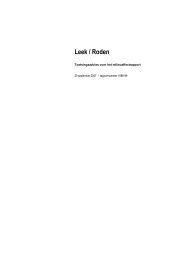Scoping Advice for the Dutch IWRM Support Programme Rwanda
Scoping Advice for the Dutch IWRM Support Programme Rwanda
Scoping Advice for the Dutch IWRM Support Programme Rwanda
Create successful ePaper yourself
Turn your PDF publications into a flip-book with our unique Google optimized e-Paper software.
1.4 Approach taken by <strong>the</strong> NCEAIn <strong>Rwanda</strong>, SEA practice is relatively young and implementation experience needs to be gained.The <strong>Rwanda</strong>n Environmental Management Authority (REMA) published general guidelines andprocedures <strong>for</strong> SEA in 2011. Specific sectoral guidance is not yet available. However, it isconsidered international best practice to tailor each SEA as much as possible to fit <strong>the</strong> specificplanning process at hand. For this reason <strong>the</strong> NCEA has developed tailor-made advice <strong>for</strong> <strong>the</strong>scope as well as <strong>the</strong> process and design <strong>for</strong> this particular SEA in close collaboration with <strong>the</strong> EKNand <strong>the</strong> RWRD. For this, <strong>the</strong> NCEA made use of its own practical SEA experience, <strong>the</strong> SEAguidelines in <strong>Rwanda</strong> 7 , and international experience like <strong>the</strong> OECD/DAC SEA guidance 8 .This report differs in character from <strong>the</strong> usual NCEA scoping reports. This stems from <strong>the</strong> proactivenature of this SEA, starting at a moment when <strong>the</strong> <strong>for</strong>mulation of <strong>the</strong> programme has notyet <strong>for</strong>mally begun. This requires <strong>the</strong> integration of scoping <strong>for</strong> <strong>the</strong> <strong>for</strong>mulation of <strong>the</strong>programme, with scoping <strong>for</strong> <strong>the</strong> SEA. To allow <strong>for</strong> scoping <strong>for</strong> <strong>the</strong> programme, however, oneneeds to have a basic understanding of <strong>the</strong> policy field <strong>the</strong> programme aims to support: <strong>IWRM</strong>.The Government of <strong>Rwanda</strong>, through <strong>the</strong> <strong>Rwanda</strong> Water Resources Department (RWRD), is makingrelatively fast progress in developing its policy framework <strong>for</strong> <strong>IWRM</strong>, and is getting ready to make<strong>the</strong> step towards implementation. It <strong>the</strong>re<strong>for</strong>e welcomes <strong>the</strong> support of <strong>the</strong> EKN. However with thishigh rate of progress being made, it is crucial to align <strong>the</strong> EKN’s support programme as much aspossible with <strong>the</strong> current state of <strong>IWRM</strong> development in <strong>Rwanda</strong>.For <strong>the</strong>se reasons, <strong>the</strong> NCEA has decided to structure this advisory report on <strong>the</strong> proposed SEA asfollows:- first, in Chapter 2, <strong>the</strong> report sets <strong>the</strong> scope in terms of <strong>the</strong> current setting of <strong>IWRM</strong> in<strong>Rwanda</strong>;- building on <strong>the</strong> previous’ chapters findings, Chapter 3 focuses on <strong>the</strong> possible scope <strong>for</strong> <strong>the</strong>support programme itself, assessing its consistency with <strong>the</strong> state of affairs of <strong>IWRM</strong>development in <strong>the</strong> country, and giving recommendations on how to align <strong>the</strong> two;- Chapter 4 <strong>the</strong>n provides guidance on <strong>the</strong> design and process of <strong>the</strong> SEA <strong>for</strong> <strong>the</strong> EKN’s <strong>IWRM</strong>support programme. To optimise <strong>the</strong> use of <strong>the</strong> SEA instrument, two additional SEAs areproposed, one <strong>for</strong> <strong>the</strong> upcoming National Water Resources Master Plan and one (or more) at alater stage <strong>for</strong> subsequent catchment plans -allowing <strong>for</strong> efficient temporal, spatial andtechnical phasing of SEA <strong>for</strong> <strong>IWRM</strong>;- The report concludes in Chapter 5 with specific terms of reference <strong>for</strong> each SEA, and looks atimplementation and management of <strong>the</strong> proposed SEA processes.7 General Guidelines and Procedures <strong>for</strong> Strategic Environmental Assessment, REMA, June 20118OECD DAC Guidelines and Reference Series Strategic Environmental Assessment: Applications in Development Co-operation,www.seataskteam.net.5



